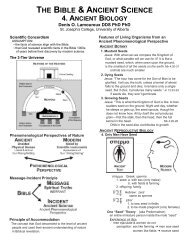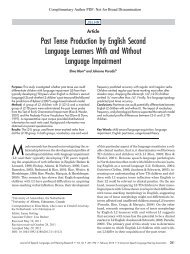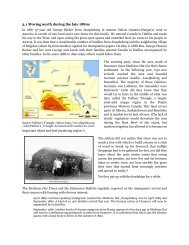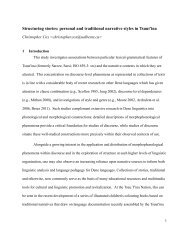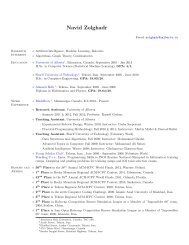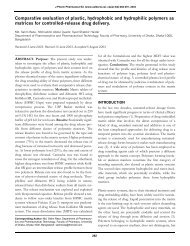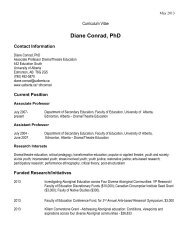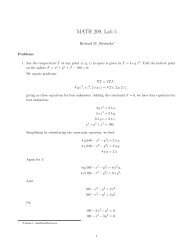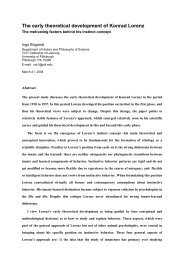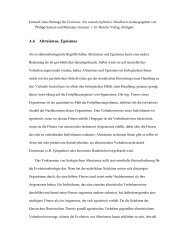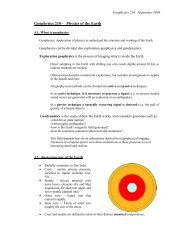Processing of Primary Fischer-Tropsch Products - University of Alberta
Processing of Primary Fischer-Tropsch Products - University of Alberta
Processing of Primary Fischer-Tropsch Products - University of Alberta
You also want an ePaper? Increase the reach of your titles
YUMPU automatically turns print PDFs into web optimized ePapers that Google loves.
(RON=55 and MON=51) content and the presence <strong>of</strong> oxygenates, it is not<br />
suitable for direct blending. Unlike the even numbered molecules, 1-heptene is<br />
not a high valued product either, although it is possible to convert 1-heptene to 1-<br />
octene [50]. Reforming does not convert C7 molecules well and CJC6 skeletal<br />
isomerisation technology can tolerate C7's in low concentration only.<br />
Oligomerisation to produce diesel is practised commercially, but it is currently<br />
expensive. The alternatives are limited and the preferred refining option for<br />
petrol production is:<br />
9 Aromatisation: The advantages <strong>of</strong> non-acidic Pt/L-zeolite aromatisation cited<br />
for the conversion <strong>of</strong> C6 hydrocarbons, apply equally well to C7 hydrocarbon<br />
conversion. The only difference is that the main product is toluene<br />
(RON=120 and MON-103), not benzene. In commercial applications the C6's<br />
and C7's are processed together, with subsequent benzene and toluene<br />
separation. Despite the absence <strong>of</strong> sulphur in the feed, hydrogenation <strong>of</strong><br />
oxygenates in the feed is required as pre-processing step. The large volume <strong>of</strong><br />
hydrogen generated also makes hydrogen recovery desirable as a post-<br />
processing step.<br />
Future processing <strong>of</strong> the C7 hydrocarbons at the Sasol Secunda refineries<br />
will entail catalytic cracking [16]. Although this is a costly refining approach, it<br />
was justified based on the local conditions and existing on-site infrastructure for<br />
propylene processing.<br />
3.2.6 Cs hydrocarbons<br />
The linear 1-0ctene present in high concentration in the C8 hydrocarbons<br />
has the same commercial benefit as 1-hexene as a valuable co-monomer, but it is<br />
considerably more difficult to purify. The oxygenates are not only more<br />
concentrated, but they also contain some carboxylic acids. However, once a<br />
decision has been made to install a process to separate the oxygenates from the<br />
hydrocarbons (e.g. by extractive distillation) then the remaining olefins are also<br />
worth recovering. Since the FT product is very olefinic and has a low degree <strong>of</strong><br />
branching, the olefins can alternatively be used as feed for hydr<strong>of</strong>ormylation to<br />
produce plasticizer alcohols. It is possible to upgrade more than 60% <strong>of</strong> the C8<br />
hydrocarbons to high value chemical products once the oxygenates have been<br />
removed. Irrespective <strong>of</strong> whether these opportunities are exploited, the<br />
oxygenates must be removed prior to further refining and the alternative is<br />
hydrotreating. The preferred fuel refining options are:<br />
9 Aromatisation: Like C6's and C7's it is possible to use non-acidic Pt/L-zeolite<br />
based technology to convert C8 hydrocarbons to aromatics. The xylenes and<br />
ethyl benzene have high octane values and are good fuel blending<br />
components. Since the feed is low in naphthenics (cyclo-paraffins), better<br />
yields can be expected than with normal reforming, but this advantage is<br />
495



